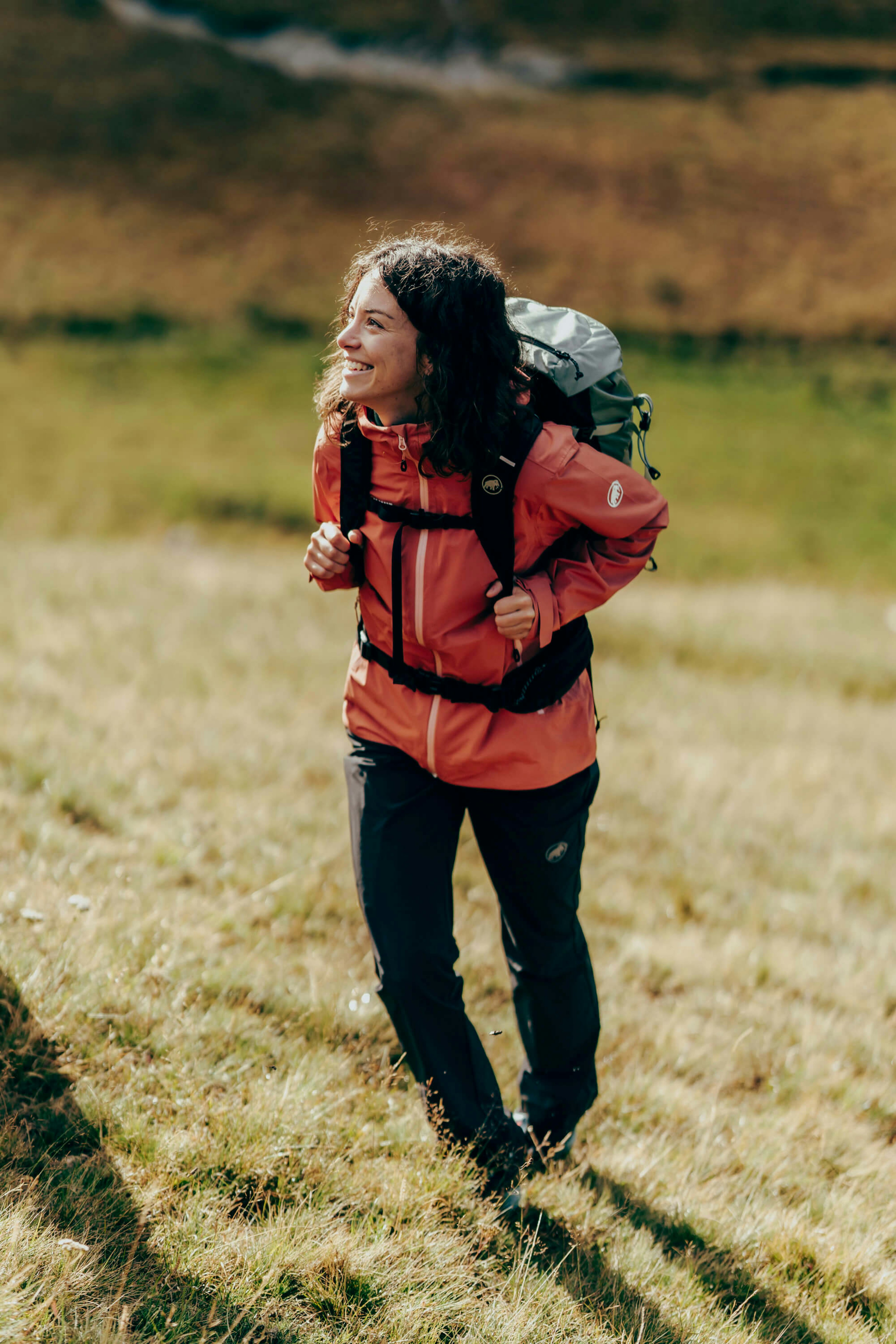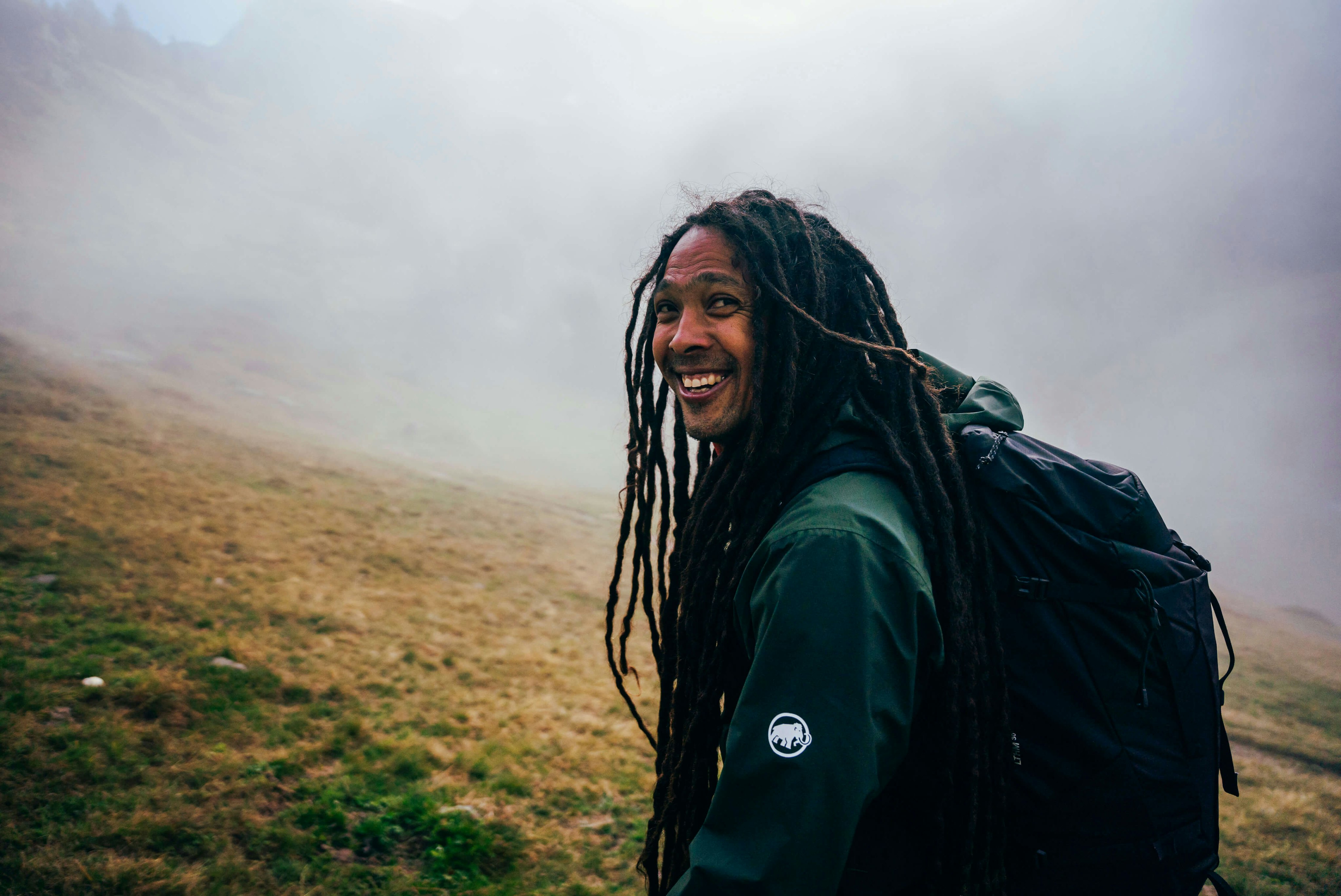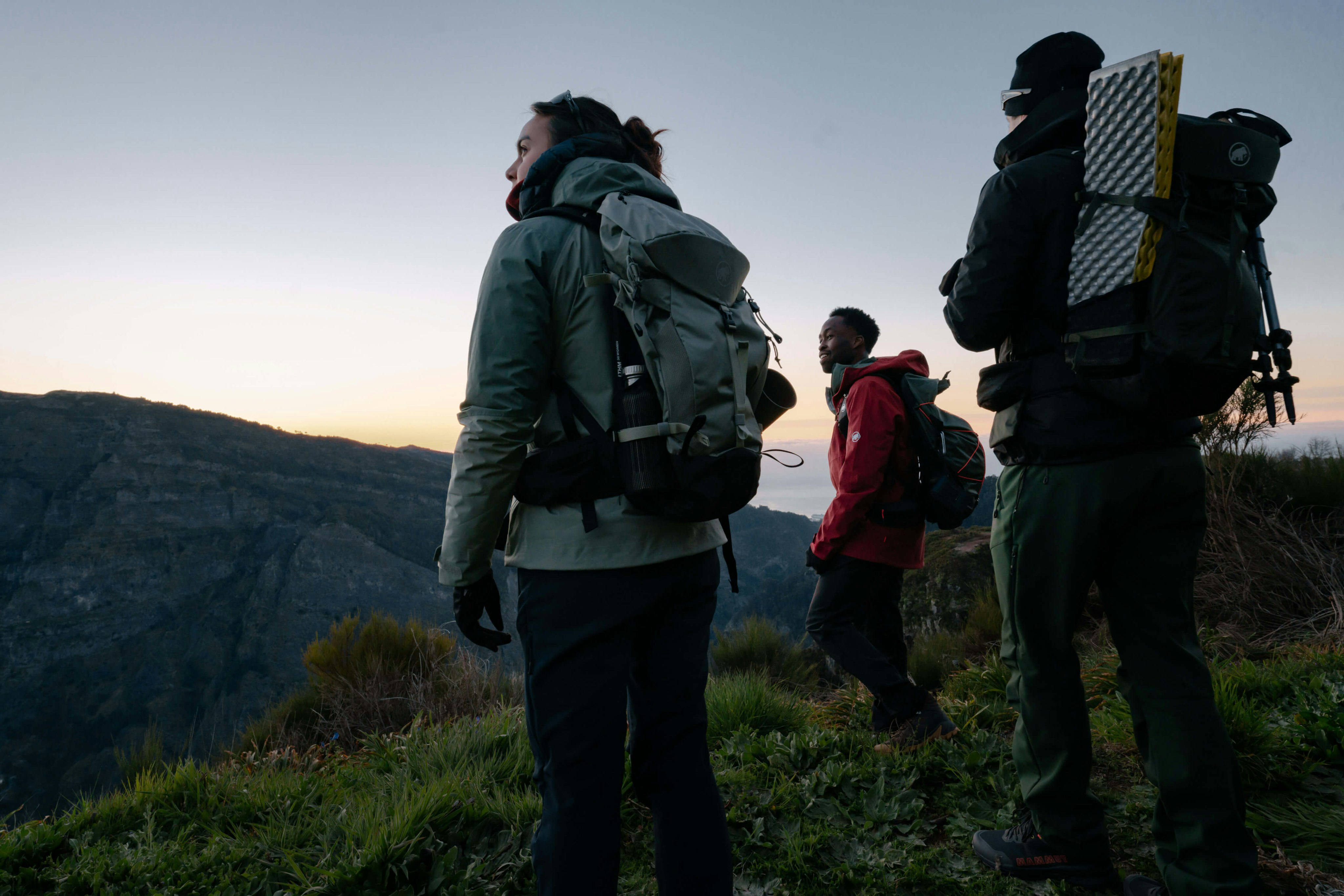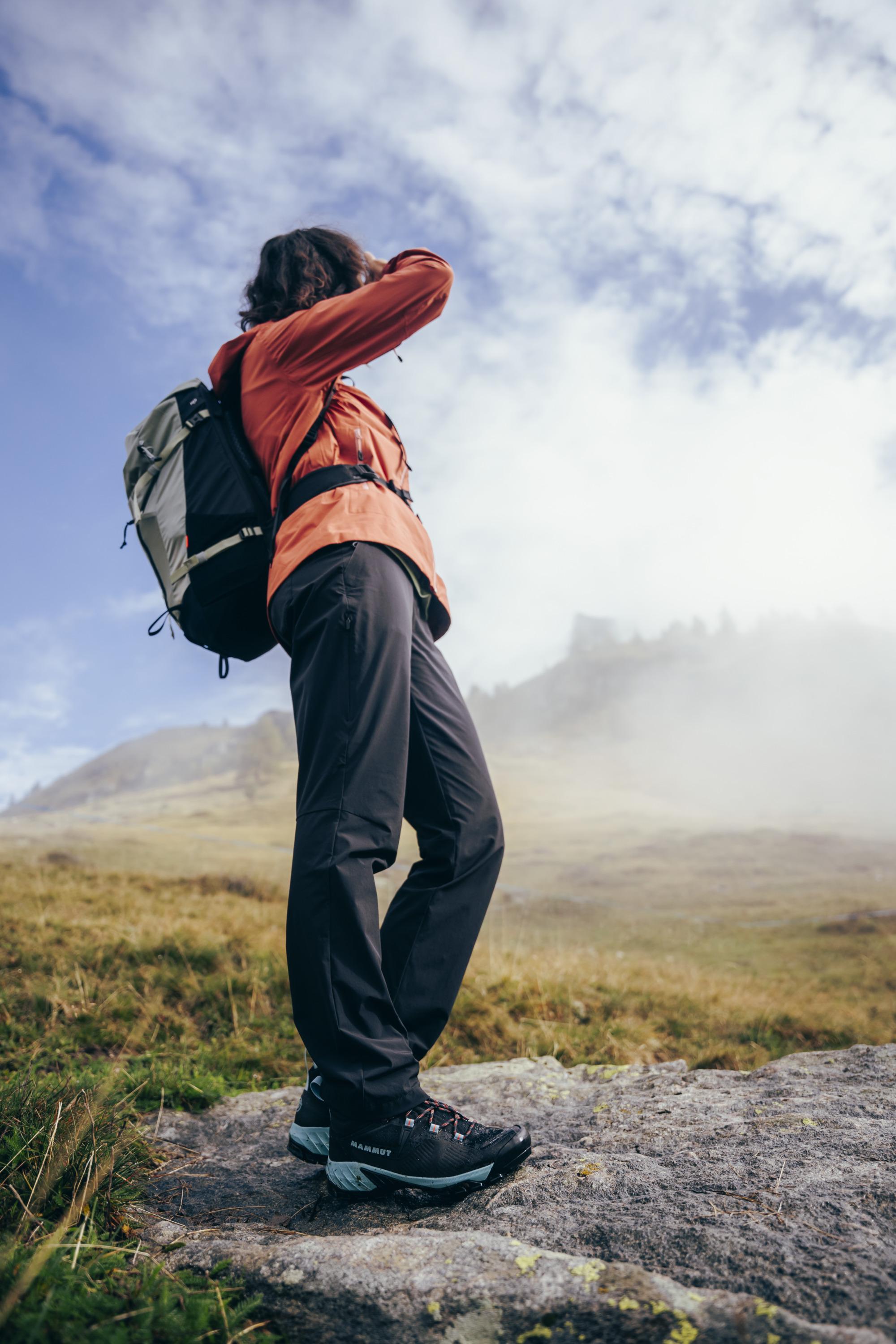Backpacking gear checklist: 10 ultimate hiking essentials
03/2024

Whether you’re heading out for a day trip or embarking on a tour spanning several days, whether you happen to get stuck in a thunderstorm or missed a turn, your backpack’s got your back – assuming you’ve packed all the right things. If you have your essential gear with you, you’ll make it through every adventure, however planned or unplanned. As the saying goes: Take as little as possible, and as much as you need. That’s why we’ve put together a list of the top 10 hiking essentials you should always take with you.
Without much further ado, let’s take a look at how to get your hiking backpack ↗ set up for your next tour. Here’s an overview of the 10 ultimate essentials you definitely don’t want to leave behind:
Backpack
Clothing and shoes
Navigational tools
Light
Sun protection
First aid kit
Pocket knife
Firelighters
Equipment for bivouacking
Food and drink
1. Backpack
Before you get packing, you obviously need a backpack. If you’re only out for the day, aim for a packing volume of about 20 liters. If you’ve got a longer tour planned with up to two overnight stays, you should pick a model with a volume of 30 to 50 liters. How much space you need obviously also depends on where you’re going to stay the night. If you’re spending three nights in a cabin, 30-35 liters will do the trick. If you’re planning to set up your tent, mat and sleeping bag outdoors, a backpack with up to 50 liters capacity is the way to go.
Depending on the distance you’re planning to cover on your hike, weight and wearing comfort should be more of a priority when choosing a backpack. For day trips that tend to require only little equipment or gear, a lightweight backpack without frame is usually sufficient. If you’re out and about for longer or need to carry some heavy gear, better opt for a hiking backpack ↗ or mountaineering backpack ↗ with an integrated metal frame – this will help distribute the weight evenly across your body.
Before heading off, always make sure your backpack is correctly adjusted. All Mammut hiking and mountaineering backpacks are fitted with fully adjustable shoulder, chest and waist straps to help you adjust the length and position to fit your body. We also carry backpacks for women. These have been specifically tailored to complement the female physique, including a shorter back, as well as shorter waist straps.
So you’ve finally packed everything you need, down to the last change of clothes – only to find everything dripping wet when taking stuff out of your backpack? Luckily, this won’t happen to you, because all Mammut backpacks are made out of water-repellent materials. This means you can rest assured that your equipment will be kept safe and dry, even when it’s raining. However, if you’re exploring a region with lots of rainfall, or spend more than three days in torrential rain, it may be worth considering adding an extra layer of protection with a rain cover. These covers are already integrated into many of our backpacks. And for those who already have a backpack, but no extra cover, we’ve got the perfect solution, too: Our hiking accessories ↗ include a large number of separate rain covers in various sizes.
2. Clothing and shoes
Whether you’re trudging through the deepest snow or whether the warm sun is beating down on your face, always check the weather forecast to make sure you choose the appropriate hiking gear ↗ for your outdoor adventure. You may also want to consider taking additional clothing that goes beyond the basics to be ready to face any type of weather Mother Nature decides to throw at you.
As far as footwear goes, the type of surface you’ll be walking on should be the basis for the type of shoe you should pick. If you’re about to head out for a relaxed hike on flat trails, low-cut hiking shoes ↗ or trail running shoes ↗ will do the job just fine. If you’re exploring rocky mountain paths or wild and untamed terrain, hiking boots or mountaineering boots ↗ that go all the way up to your ankle will give you the support you need.
Once you’re outside, an extra pair of warm socks or a fleece jacket can be virtual lifesavers. That’s why we’ve put together a list of essential clothing for every type of trek and weather condition:
Depending on the season: base layers ↗
Breathable hiking T-shirts ↗
Quick-drying hiking pants ↗ or hiking shorts ↗
Lightweight fleece jacket ↗ or insulated jacket ↗
Hiking shoes ↗ suitable for your chosen trail
Socks
Additional clothing: Depending on the weather and temperature, you can also pack a beanie ↗ or warm jacket.



3. Navigational tools
In the age of smartphones, map and compass may feel a little bit retro, but to this day they are leading the way – and give you that much-needed plan B if your cell battery should die halfway to your destination. To have the best possible navigational tools at your disposal, a mix between modern technology and tried-and-tested analogue methods is the way to go:
A topographic map is a must in any backpack, regardless of how short your hike may be.
Don’t forget your compass – a map alone won’t take you very far.
A GPS-device allows you to precisely determine your location at any given time. If you’re planning on using your smartphone, make sure to keep it in a robust protective cover – or use a specialized outdoor GPS-system.
An altimeter will help you stay on track when you need to cover a lot of elevation gain.
Exploring an area without a cell phone signal? In case of an emergency, a PLB (Personal Locator Beacon) will allow you to send your GPS-location to first responders.
Want the best of both worlds and more? With our stylish Vertical Titanium Suunto x Mammut ↗ sport watch, which combines altimeter, GPS and many other handy functionalities, you can tick off several items on your checklist in one go. As with all electronics: Make sure to charge your devices before you head out into the great outdoors, and always carry extra batteries or power banks. Another important word of advice: When it’s freezing cold outside, you should carry your devices and batteries close to your body, as low temperatures will negatively affect their load capacity.
4. Light
If you’ve got many completed treks and tours to your name, you obviously know how quickly a day tour can turn into an evening trek – or even a night trail if you accidentally miss a turn. So even if you haven’t got an overnight stay planned, you should always take a flashlight with you. The most practical choice is a head lamp – not only does it provide the necessary light to help you see everything in your field of vision, but you also have your hands free to make a fire or cook. And because we can’t stress it enough: Don’t forget about those extra batteries!
5. Sun protection
The sun can be your best friend when roaming the great outdoors – providing you’ve got the right protection. Here’s an overview of what makes for great all-round sun protection:
Sunglasses: Your eyes are one of the most sensitive body parts. Make sure to pack sunglasses that provide full UVA and UVB protection. Special glacier goggles will protect you against snow blindness when you’re mountaineering.
Sunscreen: The moment you spend a prolonged time outside in the sun, the risk of catching a sunburn goes up significantly. To protect your skin against UV-rays, depending on your skin type, you should always wear sunscreen with at least 30 LPF, and re-apply it throughout the day.
Hiking T-shirts ↗ or long-sleeved shirts ↗ with integrated UV-protection: The best type of sun protection? The kind that doesn’t let sun rays reach your skin in the first place. In our Mammut Online Shop ↗, you’ll find an extensive range of tops with integrated LPF 50+.
Head covering: As important as it is to protect your face, you shouldn’t forget about your head. Caps and hats ↗ are the perfect choice to protect yourself against sunstrokes, and to keep those UV-rays at bay.
6. First aid kit
Whatever type of trek you're conquering, there’s simply no way around a first aid kit. Equally important, though: having the medical knowledge to correctly use every component of your kit. All first aid kits from Mammut include the essentials you need, as well as detailed instructions on how to use them. That being said, many outdoor lovers prefer to put together their individual kits. Whatever your preferred option, your kit should at the very least include the following items:
Blister bandages and cream
Band-aids in different sizes
Several gauze bandages
Medical tape
Disinfectant (cream or spray)
Prescription-free pain medication
Disposable gloves
Pen and paper
Rescue blanket
How extensive your kit needs to be depends on the duration of the hike, as well as the group size. Generally, it also never hurts to have a printed first-aid guide at hand.
7. Pocket knife
The success of your adventure often quite literally rests on knife's edge –especially when you need to give first aid, prepare food, chop firewood or build a makeshift shelter. The most important feature of any pocket knife is a retractable blade. While this will already go a long way in helping you navigate the great outdoors, for challenging treks that involve carrying many different types of gear and food, a knife with added functions like a screwdriver, can opener and scissors should be your first choice.
8. Firelighters
Being able to light a fire in an emergency can be life-saving. Where the all-decisive spark comes from is secondary: A lighter running on butane works as well as a set of matches, provided they’re kept in a waterproof container.
Kindlers are perfect if you want to skip a couple of steps on your way to creating a cozy campfire, especially when it’s wet outside. Dry tinder (e.g. birch bark) in a plastic bag, candles, lighting gel or firestarters (wood shavings that have been soaked in resin) are all great choices.
Granted – above the timberline or in the deepest snow, firelighters won’t be much of a help as there’s usually no firewood around. So when you’re venturing along alpine treks, it’s best to pack a camp cooker with plenty of fuel.
9. Equipment for bivouacking
When you’re about to embark on a tour that lasts several days, your sleeping bag ↗ is sure to be the first thing on your packing list. However, even for a day trip you should still take bivouacking equipment with you. Temperatures permitting, you naturally won’t need to pack your warmest down sleeping bag ↗. These basic items won’t weigh you down, but are definitely going to make a huge difference:
Every Mammut first aid kit comes with a rescue blanket already included. Don’t have one yet? Make sure you get one asap.
A bivy will offer protection against the wind and rain. If you’re all about traveling light, you may even want to opt for a lightweight, disposable bivy.
10. Food and drink
How much water you need to take with you first and foremost depends on the outside temperature, as well as the difficulty level of your chosen route. As a rule of thumb, you’ll need half a liter of water for every hour of moderate activity. That doesn’t mean that you have to take the whole required amount of water with you when you set off. Quite often, you’ll find various water sources along your route – just make sure to check beforehand whether the water really is drinkable.
Once you’ve forced yourself past the first couple of miles, your snacks suddenly taste twice as good. Most importantly though: Make sure you have enough calories when you’re out and about, especially when your hike is taking longer than expected. Energy-rich foods like granola bars, nuts, dried fruits or beef jerky are your best friends.
The next steps
While our list of hiking essentials covers everything you need to be fully equipped for your next trek, it’s only a first stepping stone when it comes to finding the perfect hiking equipment for your needs. The rest is up to you – only time and experience will help you figure out what your personal hiking essentials really are. And if you’re feeling a little bit lost, fret not! Our Stories & Guide ↗ is packed with inspiration and helpful tips to safely guide you along the way.